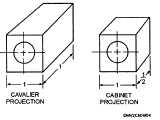Oblique Projections, Continued
Receding lines
Lines perpendicular to the plane of projection appear in oblique projection
drawings as parallel inclined lines. These lines appear to recede but never to
converge; hence the name, receding lines.
Angles of
receding lines
You may draw receding lines at any convenient angle. The angle you select
to draw receding lines depends on the shape of the object and the location of
any significant surface features. Use a large angle to draw receding lines
when you want a better view of the top of an object.
Use a small angle when
you want to show features on the side of an object.
Choose angles easily
drawn with 45° and 30°/60° triangles.
Length of
receding lines
Oblique projections present an unnatural appearance to the eye because the
receding lines do not converge into a vanishing point but remain parallel and
seem to diverge in the distance. The length of the receding lines contributes
to distortion. Receding lines drawn in full scale give the appearance of being
too long and raising the back of the object higher than the top or front
surface. For this reason, objects with great length should not be drawn in the
oblique with the longest dimension perpendicular to the plane of projection.
For the object to appear more natural, foreshorten the receding lines.
Oblique projections with full scale receding lines are known as cavalier
projections. Drawings where the receding lines are foreshortened by half are
referred to as cabinet projections.
Figure 6-4 illustrates the difference in distortion between a cavalier and
cabinet projection.
Figure 6-4.—A
distorted cavalier
projection and
foreshortened cabinet
projection of a cube.
Continued on next page
6-6

